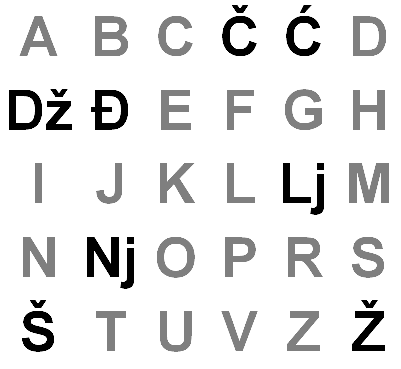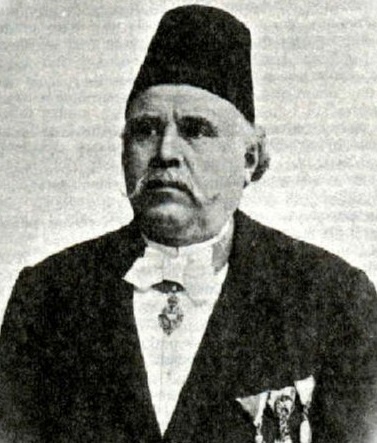|
Serbo-Croatian
Serbo-Croatian ( / ), also known as Bosnian-Croatian-Montenegrin-Serbian (BCMS), is a South Slavic language and the primary language of Serbia, Croatia, Bosnia and Herzegovina, and Montenegro. It is a pluricentric language with four mutually intelligible Standard language, standard varieties, namely Serbian language, Serbian, Croatian language, Croatian, Bosnian language, Bosnian, and Montenegrin language, Montenegrin. South Slavic languages historically formed a dialect continuum. The region's turbulent history, particularly due to the expansion of the Ottoman Empire, led to a complex dialectal and religious mosaic. Due to population migrations, Shtokavian became the most widespread supradialect in the western Balkans, encroaching westward into the area previously dominated by Chakavian and Kajkavian. Bosniaks, Croats, and Serbs differ in religion and were historically often part of different cultural spheres, although large portions of these populations lived side by side und ... [...More Info...] [...Related Items...] OR: [Wikipedia] [Google] [Baidu] |
Serbian Language
Serbian (, ) is the standard language, standardized Variety (linguistics)#Standard varieties, variety of the Serbo-Croatian language mainly used by Serbs. It is the official and national language of Serbia, one of the three official languages of Bosnia and Herzegovina and co-official in Montenegro and Kosovo. It is a recognized minority language in Croatia, North Macedonia, Romania, Hungary, Slovakia, and the Czech Republic. Standard Serbian is based on the most widespread dialect of Serbo-Croatian, Shtokavian (more specifically on the dialects of Šumadija–Vojvodina dialect, Šumadija-Vojvodina and Eastern Herzegovinian dialect, Eastern Herzegovina), which is also the basis of Croatian language, standard Croatian, Bosnian language, Bosnian, and Montenegrin language, Montenegrin varieties and therefore the Declaration on the Common Language of Croats, Bosniaks, Serbs, and Montenegrins was issued in 2017. The other dialect spoken by Serbs is Torlakian dialect, Torlakian in south ... [...More Info...] [...Related Items...] OR: [Wikipedia] [Google] [Baidu] |
Montenegrin Language
, pronunciation = , states = Montenegro , ethnicity = Montenegrins , speakers = 232,600 ( see text) , date = , ref = , familycolor = Indo-European , fam2 = Balto-Slavic , fam3 = Slavic , fam4 = South Slavic , fam5 = Western , fam6 = Serbo-Croatian , script = , nation = , minority = Mali Iđoš municipality ( Vojvodina, Serbia) , agency = Board for Standardization of the Montenegrin Language , iso2 = cnr , iso2comment = , iso3 = cnr , iso3comment = , lingua = part of 53-AAA-g , notice = IPA , glotto = mont1282 , glottorefname = Montenegrin Standard , fam7 = Shtokavian , fam8 = New Shtokavian , fam9 = Eastern Herzegovinian Montenegrin ( ; , ) is a normative variety of the Serbo-Croat ... [...More Info...] [...Related Items...] OR: [Wikipedia] [Google] [Baidu] |
Croatian Language
Croatian (; ) is the standard language, standardised Variety (linguistics)#Standard varieties, variety of the Serbo-Croatian pluricentric language mainly used by Croats. It is the national official language and literary standard of Croatia, one of the official languages of Bosnia and Herzegovina, Montenegro, the Serbian province of Vojvodina, the European Union and a recognized minority language elsewhere in Serbia and other neighbouring countries. In the mid-18th century, the first attempts to provide a Croatian literary standard began on the basis of the Neo-Shtokavian dialect that served as a supraregional lingua franca – pushing back regional Chakavian, Kajkavian, and Shtokavian vernaculars. The decisive role was played by Croatian Vukovians, who cemented the usage of Ijekavian Neo-Shtokavian as the literary standard in the late 19th and the beginning of the 20th century, in addition to designing a phonological orthography. Croatian is written in Gaj's Latin alphabet. B ... [...More Info...] [...Related Items...] OR: [Wikipedia] [Google] [Baidu] |
South Slavic Languages
The South Slavic languages are one of three branches of the Slavic languages. There are approximately 30 million speakers, mainly in the Balkans. These are separated geographically from speakers of the other two Slavic branches (West Slavic languages, West and East Slavic languages, East) by a belt of German language, German, Hungarian language, Hungarian and Romanian language, Romanian speakers. History The first South Slavic language to be written (also the first attested Slavic language) was the variety of the Eastern South Slavic spoken in Thessaloniki, now called Old Church Slavonic, in the ninth century. It is retained as a liturgical language in Slavic Eastern Orthodox Church, Orthodox churches in the form of various local Church Slavonic language, Church Slavonic traditions. Classification The South Slavic languages constitute a Dialect continuum#South Slavic continuum, dialect continuum. Serbian, Croatian, Bosnian, and Montenegrin constitute a single dialect wit ... [...More Info...] [...Related Items...] OR: [Wikipedia] [Google] [Baidu] |
Bosnian Language
Bosnian (; / ; ), sometimes referred to as Bosniak ( / ; ), is the standard language, standardized Variety (linguistics)#Standard varieties, variety of the Serbo-Croatian pluricentric language mainly used by ethnic Bosniaks. Bosnian is one of the three official languages of Bosnia and Herzegovina, alongside Croatian language, Croatian and Serbian language, Serbian, all of which are Mutual intelligibility#List of dialects or varieties sometimes considered separate languages, mutually intelligible. It is also an officially recognized minority language in Croatia, Serbia, Montenegro, North Macedonia and Kosovo. Bosnian uses both the Gaj's Latin alphabet, Latin and Serbian Cyrillic alphabet, Cyrillic alphabets, with Latin in everyday use. It is notable among the variety (linguistics), varieties of Serbo-Croatian for a number of Arabic, Persian language, Persian and Ottoman Turkish loanwords, largely due to the language's interaction with those cultures through Islam in Bosnia and H ... [...More Info...] [...Related Items...] OR: [Wikipedia] [Google] [Baidu] |
Gaj's Latin Alphabet
Gaj's Latin alphabet ( sh-Latn-Cyrl, Gajeva latinica, separator=" / ", Гајева латиница}, ), also known as ( sr-Cyrl, абецеда, ) or ( sr-Cyrl, гајица, link=no, ), is the form of the Latin script used for writing all four standard varieties of Serbo-Croatian: Bosnian language, Bosnian, Croatian language, Croatian, Montenegrin language, Montenegrin, and Serbian language, Serbian. It contains 27 individual letters and 3 digraphs. Each letter (including digraphs) represents one Serbo-Croatian phonology, Serbo-Croatian phoneme, yielding a highly phonemic orthography. It closely corresponds to the Serbian Cyrillic alphabet. The alphabet was initially devised by Croatian linguist Ljudevit Gaj in 1835 during the Illyrian movement in Croats, ethnically Croatian parts of the Austrian Empire. It was largely based on Jan Hus's Czech alphabet and was meant to serve as a unified orthography for Triune Kingdom, three Croat-populated kingdoms within the Austrian Empi ... [...More Info...] [...Related Items...] OR: [Wikipedia] [Google] [Baidu] |
Slavic Languages
The Slavic languages, also known as the Slavonic languages, are Indo-European languages spoken primarily by the Slavs, Slavic peoples and their descendants. They are thought to descend from a proto-language called Proto-Slavic language, Proto-Slavic, spoken during the Early Middle Ages, which in turn is thought to have descended from the earlier Proto-Balto-Slavic language, linking the Slavic languages to the Baltic languages in a Balto-Slavic languages, Balto-Slavic group within the Indo-European family. The current geographical distribution of natively spoken Slavic languages includes the Balkans, Central and Eastern Europe, and all the way from Western Siberia to the Russian Far East. Furthermore, the diasporas of many Slavic peoples have established isolated minorities of speakers of their languages all over the world. The number of speakers of all Slavic languages together was estimated to be 315 million at the turn of the twenty-first century. It is the largest and most d ... [...More Info...] [...Related Items...] OR: [Wikipedia] [Google] [Baidu] |
Bosniaks
The Bosniaks (, Cyrillic script, Cyrillic: Бошњаци, ; , ) are a South Slavs, South Slavic ethnic group native to the Southeast European historical region of Bosnia (region), Bosnia, today part of Bosnia and Herzegovina, and who share a common Genetic studies on Bosniaks, ancestry, Culture of Bosnia and Herzegovina, culture, History of Bosnia and Herzegovina, history and the Bosnian language. Traditionally and predominantly adhering to Sunni Islam, they constitute native communities in what is today Bosnia and Herzegovina, Serbia, Montenegro, Croatia and the Republic of Kosovo. Largely due to displacement stemming from the Bosnian War in the 1990s they also make up a significant diaspora with several communities across Europe, the Americas and Oceania. Bosniaks are typically characterized by their historic ties to the Bosnia (region), Bosnian historical region, adherence to Islam in Bosnia and Herzegovina, Islam since the 15th and 16th centuries, Culture of Bosnia an ... [...More Info...] [...Related Items...] OR: [Wikipedia] [Google] [Baidu] |
Arebica
Arebica (عربٖىڄا ,آرەبـٖٮڄآ; ) is a variant of the Perso-Arabic script used to write the Serbo-Croatian language. It was used mainly between the 15th and 19th centuries and is frequently categorized as part of Aljamiado literature. During Austro-Hungarian rule, there were unsuccessful efforts by Bosnian Muslims to grant Arebica equal status alongside Latin and Cyrillic alphabets. Apart from literature, Arebica was used in religious schools and administration, though in much less use than other scripts. Origin Arebica was based on the Perso-Arabic script of the Ottoman Empire, with added letters for , and , which are not found in Arabic, Persian or Turkish. Full letters were eventually introduced for all vowels (as with Kurdish Arabic script), making Arebica a true alphabet, unlike its Perso-Arabic base. Arebica was used by the Slavic Muslims in Central Bosnia during the Ottoman rule and continued usage during the Austro-Hungarian rule in Bosnia and Herze ... [...More Info...] [...Related Items...] OR: [Wikipedia] [Google] [Baidu] |
Languages Of Montenegro
Languages of Montenegro are languages that are spoken in Montenegro. According to the Constitution of Montenegro that was adopted in 2007, Montenegro has only one official language, specified as Montenegrin, even though Serbian is used by 43% of the population and Montenegrin by 35% of population. There is an ongoing debate about the distinct nature of Montenegrin language in relation to the Serbo-Croatian dialectal continuum. Montenegrin can be written in both the Latin and Cyrillic alphabets, but there is a growing political movement to use only the Latin alphabet. Legally recognized minority languages are Albanian, Bosnian, and Croatian. As of 2017, Albanian is an official language of the municipalities of Podgorica, Ulcinj, Bar, Pljevlja, Rozaje and Tuzi. Additionally, there are a few hundred Italians in Montenegro, concentrated in the Bay of Kotor (''Cattaro''). Romani is a protected language. Minority languages of Montenegro The European Charter for Regional ... [...More Info...] [...Related Items...] OR: [Wikipedia] [Google] [Baidu] |
Croats
The Croats (; , ) are a South Slavs, South Slavic ethnic group native to Croatia, Bosnia and Herzegovina and other neighboring countries in Central Europe, Central and Southeastern Europe who share a common Croatian Cultural heritage, ancestry, Culture of Croatia, culture, History of Croatia, history and Croatian language, language. They also form a sizeable minority in several neighboring countries, namely Croats of Slovenia, Slovenia, Burgenland Croats, Austria, the Croats in the Czech Republic, Czech Republic, Croats in Germany, Germany, Croats of Hungary, Hungary, Croats of Italy, Italy, Croats of Montenegro, Montenegro, Croats of Romania, Romania, Croats of Serbia, Serbia and Croats in Slovakia, Slovakia. Due to political, social and economic reasons, many Croats migrated to North and South America as well as New Zealand and later Australia, establishing a Croatian diaspora, diaspora in the aftermath of World War II, with grassroots assistance from earlier communities an ... [...More Info...] [...Related Items...] OR: [Wikipedia] [Google] [Baidu] |








